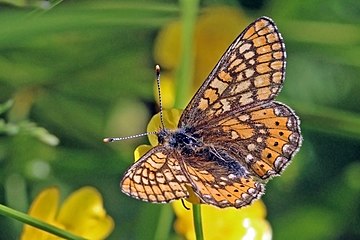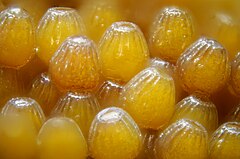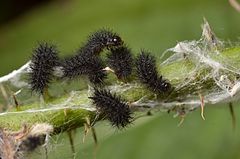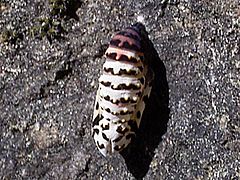Marsh fritillary
| Euphydryas aurinia | |
|---|---|

| |
| male E. a. aurinia, Dorset | |

| |
| female E. a. aurinia, Dorset | |
| Scientific classification | |
| Kingdom: | |
| Phylum: | |
| Class: | |
| Order: | |
| Family: | |
| Genus: | |
| Species: | E. aurinia
|
| Binomial name | |
| Euphydryas aurinia (Rottemburg, 1775)
| |
| Synonyms[1] | |
|
List
| |
The marsh fritillary (Euphydryas aurinia) is a butterfly of the Nymphalidae family.
Taxonomy
E. aurinia is represented by many subspecies. The most widely accepted are:
- Euphydryas aurinia aurinia central Europe, southern Europe, western Siberia
- Euphydryas aurinia bulgarica (Fruhstorfer, 1916) Carpathian Mountains
- Euphydryas aurinia laeta (Christoph, 1893) central Siberia, Altai, Sayan, Transbaikal
- Euphydryas aurinia beckeri (Lederer, 1853) Morocco (Middle Atlas, Rif Mountains)
- Euphydryas aurinia barraguei (Betz, 1956) Algeria
- Euphydryas aurinia provincialis (Boisduval, 1828) (France and northern Italy)
but the total number of described subspecies is much higher especially in the eastern Palaearctic. The insect may be best considered a superspecies.
-
E. a. aurinia male
-
E. a. beckeri
-
E. a. provincialis
-
E. a. estonica, Estonia
Distribution
This species is widespread in the east Palaearctic ecozone from Ireland in the west to Yakutia in the east, and to north-west China and Mongolia in the south.[2][3] The marsh fritillary is in decline in Europe and it is one of eleven butterflies covered by the United Kingdom Biodiversity Action Plan. Within the British Isles, it is more frequent in the south and west.[4]
Habitat
This species lives in calcareous grassland, in woodland clearings and in damp marshy areas (hence the common name) and in heathy grassland, dominated by tussock forming grasses, including purple moor and rush pastures. These butterflies can reach an elevation of 10–2,200 metres (33–7,218 ft) above sea level.[5]
In the British Isles the marsh fritillary is usually to be found in damp heathy grasslands which are called rhos pastures from the Welsh word rhos meaning heath, but the species does exist in other types of habitats which are drier, like neutral grasslands or dry calcareous grasslands. Small populations may be seen where there is not a lot of the larval food plant present. Small populations can be an important element of the ecology because they can produce lots of mobile individuals which can found other populations. The marsh fritillary is protected under British law. It is listed under Schedule 5 of the Wildlife and Countryside Act, also the EU Habitats and Species Directive (Annex II).
The Devon Wildlife Trust owns a number of sites for which it monitors this species. Examples include Stowford Moor (near Holsworthy, Devon), Dunsdon nature reserve (near Bude), Mambury Moor (near Great Torrington), Vealand Farm nature reserve (near Holsworthy), Volehouse Nature Reserve (near Holsworthy). In 2009, counts of number of species had significantly increased from years 2007 and 2008.[4][6]
Description
Euphydryas aurinia has a wingspan of 30–42 millimetres (1.2–1.7 in) in males.[7] The females are usually larger than the males, with a wingspan of 40–50 millimetres (1.6–2.0 in).[5] These small butterflies are very variable in markings and colouration, with many forms and subspecies. The adult butterflies usually show a chequered pattern of brown, orange and yellow markings. Yellow markings are present on the hindwing edge. The underside of the wings is patterned with yellow orange and brown without any silver colouration at all.[8] The eggs are yellow identified by being in a large batch, and the larvae are black.
-
Underside
Biology
Euphydryas aurinia is a univoltine species. The eggs are laid in groups on the underside of the leaves in May and June. Up to 350 are laid in a single batch. They turn from pale yellow when first laid, to bright yellow, then crimson, and finally to dark grey just prior to hatching. The caterpillars hatch from the end of June onwards. The young caterpillars live in communal webs that are spun across the food plant and these become conspicuous by the end of August.[7] In the autumn they make stronger webs, closer to the ground usually within a dense grass tussock, where they will start to hibernate. In the spring the caterpillars start to disperse from their communities after their last moult. They change colour from brown to black and may occasionally be seen basking in the sun. They need to be warm in order to eat.
The caterpillars are recorded as feeding on Succisa pratensis and species of Digitalis, Plantago lanceolata, Knautia arvense, Scabiosa succisa, Veronica (Veronica dubravnaya, etc.), Geranium, Sambucus, Gentiana, Valeriana, Lonicera implexa, Filipendula, Spiraea and Viburnum.[2]
In the British Isles the main food plant of the larval stage of the marsh fritillary is the devil's bit scabious, Succisa pratensis,[9] but can also include the field scabious, Knautia arvensis, and the small scabious, Scabiosa columbaria.
The caterpillars are liable to be attacked by the parasitoid wasp Apanteles bignellii, especially in warm spring weather.[10] Pupae form from mid-April, low down deep within grass tussocks or dead leaves. Adults mainly emerge from mid-April to mid-July, however in southern regions they can be on wing starting from late May.[7][11]
Metapopulations
Research work on the population dynamics of the marsh fritillary has shown that they live in metapopulations. A metapopulation is defined as a collection of local populations that are connected together as a result of occasional dispersal. Amongst these some will disappear and others will be founded.[7]
Usually the marsh fritillary lives in small populations that tend to die out and new populations are founded from nearby sites. An important feature of metapopulations is that there will always be empty habitat within the system. It is possible for the majority of the habitat patches to be empty. The security of suitable places where the butterfly does not presently occur is essential to its survival in the long term.
Management
The aim is to produce an uneven patchwork of short and long vegetation by the end of the grazing period, between 8 and 25 cm. This is to allow the food plant to grow. This can be achieved through low intensity grazing using cattle and burning. Monitoring and indicators of success are mainly represented by the frequency of larval webs, the frequency of flowers and larval food plant.
Life cycle
-
Courting
-
Mating
-
Eggs
-
Young caterpillars
-
Pupa
Bibliography
- Aldwell, B. and Smyth, F. 2013. The Marsh Fritillary (Euphydryas aurinia (Rottemburg, 1775)) (Lepidoptera: Nymphalidae) in Co. Donegal. Irish Naturalists' Journal 32: 53 - 63 Crory, Andrew.(?) 2016. Fritillary Butterflies. The Irish Hare, Issue: 113. p. 4
External links
- Schmetterling-raupe.de
- Kimmo Silvonen Larvae of North-European Lepidoptera
- McKee, L. 2008. "Bid to halt decline of butterfly". Belfast Telegraph. 18 July 2008. p. 10 (www.belfasttelegraph.co.uk)
- Paolo Mazzei, Daniel Morel, Raniero Panfili Moths and Butterflies of Europe and North Africa
- Devon Wildlife Trust manages a number of strongholds for the species including Volehouse Moor, Dunsdon, Meshaw Moor and Vealand farm
References
- ^ Lepiforum.de
- ^ a b Funet
- ^ Fauna europaea
- ^ a b JNCC website: SAC selection, Annex II Species Accounts
- ^ a b UK Butterflies
- ^ Wild Devon The Magazine of the Devon Wildlife Trust,page 8 Winter 2009 edition
- ^ a b c d Butterfly Guide by Matt Rowlings
- ^ RSPB Wildlife of Britain
- ^ Howarth, T.G.1973. South's British Butterflies. p.129. Frederick Warne & Co. Ltd. ISBN 0-7232-1499-9
- ^ Learn About Butterflies
- ^ Butterflies Conservation in Armenia











